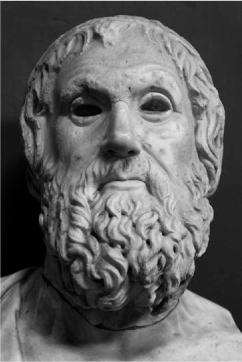Classical Greek MythologySophocles and the Oedipus Cycle |
What was the background myth of the Oedipus plays? |
The plot of Oedipus the King, as well as of the other Theban plays, was extracted from the long and complex saga of the House of Thebes, much as Aeschylus’ The Oresteia was extracted from the story of the House of Atreus. The audience at the City Dionysia would have known the whole story of Oedipus. Homer tells most of it in the Odyssey, so it had long been part of the Greek collective memory.
The audience knew that in ancient times the city of Thebes had been founded by Cadmus, famous for killing a dragon sacred to Ares. They also knew that a Theban was famous for having brought homosexuality into Greece. This Theban was Laius, who as a youth had fled Thebes in a dynasty dispute and had been given refuge by King Pelops of a nearby city. Pelops had appointed Laius as a tutor to the king’s beautiful young son Chrysippos. The tutor became strongly attracted to the boy and raped him. So it was that the eventual House of Thebes of which Laius later became king was marked at its beginning by a sin.
Laius married Jocasta, the sister of an important Theban, Creon. An oracle told the royal couple that their son would commit the unforgiveable and almost impossible-to-imagine sin of killing his father and marrying his mother. Reacting as anyone in such a position might, the couple tried to rid themselves of their infant son. Laius tied the baby’s feet together and Jocasta abandoned her child in the wilds, assuming than an animal would complete the act of infanticide. But the oracle of Apollo is not so easily undermined. A shepherd finds the child—he of the swollen feet (oedipus)—and gives him to the childless king and queen of Corinth, who raise him as their son. The young Oedipus, having been told nothing of his early history, believes the Corinthian couple to be his real parents. It is with horror, then, that he hears from an oracle that he will kill his father and marry his mother. Again, understandably, he makes the mistake of attempting to circumvent the oracle by leaving Corinth for good. At a crossroads he meets a party of travelers and becomes involved in a chariot road-rage incident. He kills the leader of the travelers, who happens to be Laius, his father, as well as most of his party and soon arrives at Thebes, where he will request sanctuary. He succeeds in answering a riddle posed by a sphinx who is blocking access to the city and holding it hostage. After killing the monster, as heroes must, Oedipus is received by the Thebans as a savior and is made king. The throne has been vacant, as the old king, Laius, has apparently been killed. It is proposed that Oedipus take the queen, Jocasta, as his wife. This he does and the couple have four children, two boys and two girls. Oedipus, of course, has no idea that he has already killed his father and married his mother. Fate and free will have converged. It must be remembered that the audience knows this whole story but that the characters portrayed on stage do not and that all of these amazing events have taken place before the play, Oedipus the King, even begins.

A fourth-century B.C.E. bust of the playwright Sophocles.
